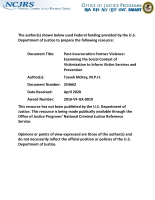Violence
Neighborhood Changes in Ecology and Violence
Neighborhood Disadvantage, Individual Economic Distress and Violence Against Women in Intimate Relationships
Factors Associated with Domestic Violence and Sexual Assault Victimization
Women's Motives for Violent and Nonviolent Behaviors in Conflicts
Comorbidity Between Abuse of an Adult and DSM-III-R Mental Disorders: Evidence From an Epidemiological Study
Does Child Abuse and Neglect Increase Risk for Perpetration of Violence Inside and Outside the Home?
Effects of Child Abuse, Adolescent Violence, Peer Approval and Pro-violence Attitudes on Intimate Partner Violence in Adulthood
Poverty, Subculture of Violence, and Type of Homicide
Physical Violence Among Anglo, African American, and Hispanic Couples: Ethnic Differences in Persistence and Cessation
Using Longitudinal Data To Understand the Trajectory of Intimate Partner Violence Over Time (From Violence Against Women and Family Violence: Developments in Research, Practice, and Policy, 2004, Bonnie Fisher, ed. -- See NCJ-199701)
Person-Oriented Methods in Partner Violence Research: Distinct Biopsychosocial Profiles Among Battered Women
Violence in Intimate Relationships: A Conceptual and Empirical Examination of Sexual and Physical Aggression
Adolescent Violence: A View From the Street
Cycle of Violence in Context: Exploring the Moderating Roles of Neighborhood Disadvantage and Cultural Norms
Fear, Social Interactions, and Violence Mitigation
Assessing the Link Between Exposure to a Violent Prison Context and Inmate Maladjustment
Severity of Dispositions and Domestic Violence Recidivism
Impact of Recent Partner Violence on Poor Women's Capacity to Maintain Work
Post-Incarceration Partner Violence: Examining the Social Context of Victimization To Inform Victim Services and Prevention
Formative Evaluation of a City-Wide Hospital-Based Victims Services Intervention in Chicago
Formative Evaluation of a Pediatric Hospital-Based Violence Intervention Program
Violence Against American Indian and Alaska Native Women and Men - 2010 Findings from the National Intimate Partner and Sexual Violence Survey
This seminar provides the first set of estimates from a national large-scale survey of violence against women and men who identified themselves as American Indian or Alaska Native using detailed behaviorally specific questions on psychological aggression, coercive control and entrapment, physical violence, stalking, and sexual violence. These results are expected to raise awareness and understanding of violence experienced by American Indian and Alaska Native people.
See the YouTube Terms of Service and Google Privacy Policy
Why Is the United States the Most Homicidal Nation in the Affluent World?
Ohio State University Since World War II, the homicide rate in the U.S. has been three to ten times higher than in Canada, Western Europe, and Japan. This, however, has not always been the case. What caused the dramatic change? Dr. Roth discussed how and why rates of different kinds of homicide have varied across time and space over the past 450 years, including an examination of the murder of children by parents or caregivers, intimate partner violence, and homicides among unrelated adults.
See the YouTube Terms of Service and Google Privacy Policy
Violent Repeat Victimization: Prospects and Challenges for Research and Practice
Research tells us that a relatively small fraction of individuals experience a large proportion of violent victimizations. Thus, focusing on reducing repeat victimization might have a large impact on total rates of violence. However, research also tells us that most violent crime victims do not experience more than one incident during a six-month or one-year time period. As a result, special policies to prevent repeat violence may not be cost-effective for most victims.
See the YouTube Terms of Service and Google Privacy Policy


